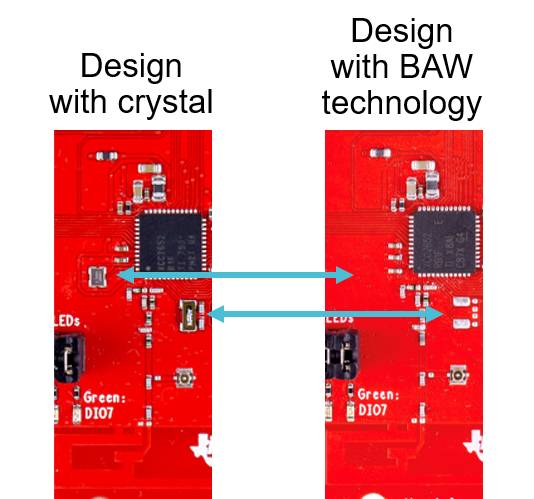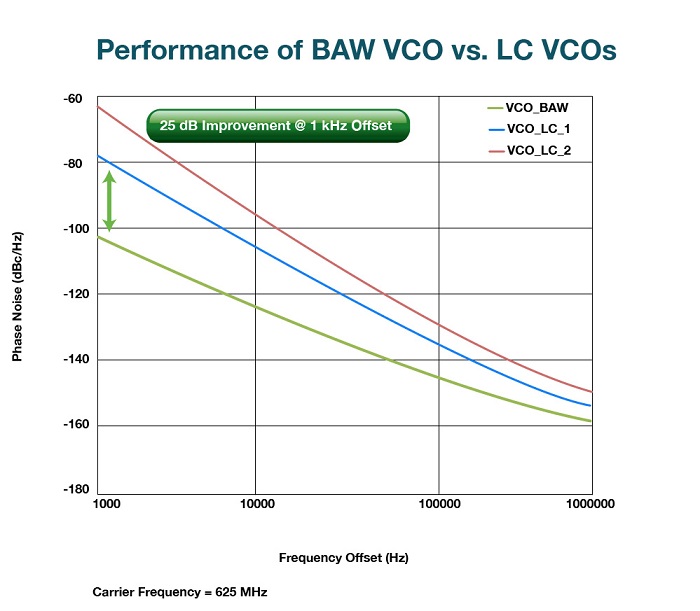By Gina Roos, editor-in-chief
Addressing the growing need to transmit more data faster and more reliably, Texas Instruments (TI) has released the first two chips based on its new bulk acoustic wave (BAW) technology for next-generation communications infrastructure. Along with improving network performance, reliability, and efficiency, the new devices — a wireless microcontroller (MCU) and network synchronizer clock — is expected to increase immunity to vibration and shock, shrink the bill of materials (BOM), and reduce design complexity.
The first devices based on TI’s BAW technology are the SimpleLink CC2652RB wireless microcontroller (MCU) and the ultra-low-jitter LMK05318 network synchronizer clock, which integrate reference clocking resonators, providing high frequency in a small form factor. By eliminating the use of discrete clocking and quartz-crystal devices in communications and industrial automation systems, these BAW devices solve a few inherent challenges of the discrete clocking devices, such as design complexity and susceptibility to environmental stress.
Today, a lot of data is being moved around, and with the IoT, things are getting more intelligent with all of the sensors being used, which puts a burden on the infrastructure and the need to move massive amounts of data either for analysis or to inform users, said Kim Wong, TI’s VP of high-speed data and clocks.
Moving and analyzing this big data creates a lot of challenges, he continued. “What we found is that as we try to enable these intelligent devices that collect all this data and move it quickly to the user or analyze the data, the current solutions are very limited, especially when we look at current clocking solutions — for example, quartz crystals. Even current conventional semiconductor solutions are simply not sufficient.”
Technical challenges become more and more critical at bandwidths as high as 400 Gbits/s, said Wong. Clocks, for example, impact the reliability of the link as well as the bandwidth, he added.
But the new technology is not just about replacing quartz devices. “We can integrate [the technology] as part of our conventional semiconductor process and make it better,” said Wong. “BAW is a micro-resonator that allows us to integrate it as part of our semiconductor chips. BAW as a foundational technology can deliver cleaner signals or cleaner clocks, for example, that can enable high bandwidth and high throughput, which is a challenge today.”
“Because it is a foundational technology, it can be incorporated into many products,” he added.
Advances in BAW technology address the limitations of current clocks and quartz-crystal devices, offering improved performance, smaller size, and lower cost, said Wong. Micro-resonator technology enables the integration of high-precision and ultra-low-jitter clocks directly into packages with other circuits (thus eliminating the need for external clocks and quartz-crystal devices and increasing resistance to mechanical stresses), which results in higher-quality communications and higher efficiency for applications such as wireless consumer electronics and high-end industrial systems.
The more stable the data transmission, the more precise the data synchronization of wired and wireless signals, which means continuous transmission and faster processing of data.
Key features of the CC2652RB:
- Industry’s first crystal-less wireless MCU
- Small footprint — integrates BAW resonator in the QFN package
- Frequency stability ±40 ppm across the full operating range
- 10% to 15% savings in PCB space
- Lowest-power multi-standard device — supports Zigbee, Thread, Bluetooth Low Energy, and proprietary 2.4-GHz connectivity
- Operating temperature range of −40°C to 85°C

Designs using the BAW technology get about a 12% savings in board space.
Key features of the LMK05318:
- First network synchronizer with integrated BAW-based resonator that enables 400-Gbits/s links
- Jitter performance of 50-fs RMS at 312.5 MHz (APLL1) and 125-fs RMS at 155.52 MHz (APLL2) without requiring additional components
- 4× better hitless switching (±50-ps phase transient) versus competition
- No in-system programming required
- Reduced BOM for ancillary components

The BAW network synchronizer delivers 25-dB-lower noise compared to devices using conventional semiconductor technology.
Wong said that the network synchronizer enables 400-Gbits/s links with ease. “One parameter that will impact the bandwidth is jitter (noise). A conventional network synchronizer that uses a conventional semiconductor process will be about two-and-a-half times noisier than the BAW network synchronizer, which will eat up the link budget.”
Another key feature of the LMK04318 is the hitless switching. It achieves 4× better hitless switching compared to competitive products, resulting in higher reliability, faster transmission, and higher bandwidth. Phase noise is 25 dB better than conventional semiconductor technology, which is very significant and will enable the bandwidth required in the market today and in the future, said Wong.
Pre-production samples of the CC2652RB (7 × 7-mm VQFN package) are now available through the TI store. Pricing starts at $3.55 in 1,000-unit quantities. A TI LaunchPad development kit is also available.
The LMK05318 (48-pin, 7 × 7-mm VQFN) is now available in production quantities through the TI store and authorized distributors. Pricing starts at $11.44 in 1,000-unit quantities. An evaluation module is available for $399 via the TI store and authorized distributors.
Advertisement
Learn more about Electronic Products MagazineTexas Instruments





